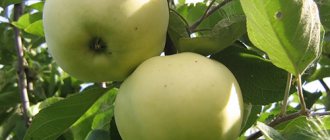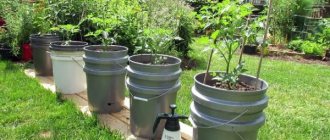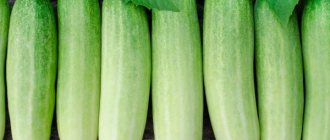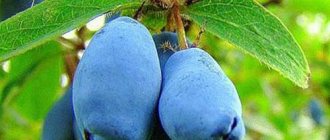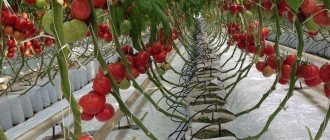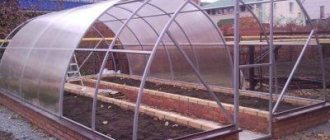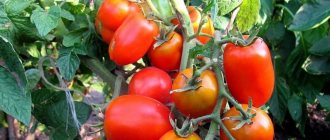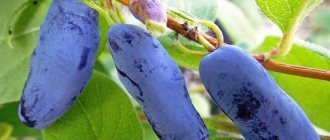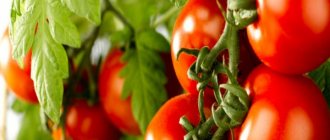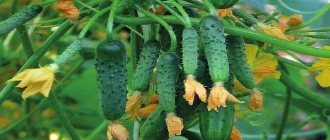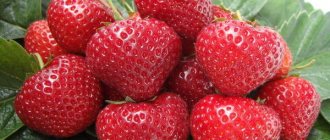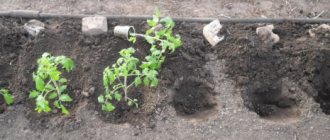Honeysuckle Blue Bird is an early ripening variety intended for cultivation in the central zone of the country and in the northwestern part. You can find many good reviews about it, and experts themselves give the culture a high rating. To achieve rapid fruiting and maximum yield, you need to plant correctly and take care. The description provides varietal characteristics and recommendations for cultivation.
Main characteristics
- The variety is early ripening, created by scientists from the Siberian Horticulture Research Institute by selecting the best specimens of Kamchatka honeysuckle.
- The fruit shoots are vigorous and can develop to a height of 1.6-1.8 m.
- The bushes are characterized by a spreading, dense oval-shaped crown.
- The fruits are medium in size with a length of 2 cm and a weight of 0.8-1.2 g.
- The berries are blue in color, oblong in the form of an ellipse.
- The pulp of ripe fruits is very soft with a sweet and sour taste.
- The skin of the hearths is very thin with a waxy coating.
- Ripe berries contain: sugar 5-6.5%, vitamin C 16-17 mg/100 g.
- The berries ripen during the second part of June.
- The variety is characterized by weak fruit shedding.
- Plants need pollination by such varieties as Malvina, Morena, Sinichka.
- The variety produces the first harvests from the third year of cultivation, and the total fruiting period lasts 23-25 years.
- The average yield from one bush is 1.2-1.5 kg of berries. In some years, you can collect up to 2.5 kg from a bush. fruits
Honeysuckle Amphora
The height of the plant varies between 1.4-1.5 m, the crown is tightly packed and shaped like a circle. The main branches are quite thick, the bark is brown in color. The shoots grow straight, the bark on them is crimson in color. The green foliage of the plant is oval in shape. The bush has an aesthetically attractive appearance, so it is used not only for harvesting, but also as a decoration for the area adjacent to the house.
The berries are of normal size: length 2 cm, weight 1.2-1.5 g (maximum weight - 3 g). The fruits have a smooth surface with a waxy coating and a thick skin.
The pulp of the berry is dense with veins, there is no pronounced aroma. The taste is sweet and sour, there is a slight bitterness and a lingonberry flavor. The harvest can be used for raw consumption or storage for the winter. The variety tolerates transportation well.
The young bush begins to bear fruit from the third year of life, the fruits ripen by the end of June. From one plant you get 0.8-1.3 kg under poor growing conditions and 1.7-2 kg under good conditions. Ripe berries stay on the branches for a long time and do not fall off. Although the variety is resistant to diseases, it is possible that leaves and young shoots may be damaged by corresponding pests.
Blue Spindle, Altair, Viola, Azure and others are planted nearby as pollinators.
Amphora
This variety was bred by Pavlovsk biologists for the cold regions of Russia. It is ideal for growing in cold regions of our country.
The bush reaches 1.5 in height, and its bark has a crimson tint, so it is often used for landscape design of personal plots.
The fruits have practically no aroma, the taste is sour with notes of bitterness. They do not fall off and have a thick peel.
The variety is not very productive and begins to bear fruit in the 3rd year of planting, but it tolerates low temperatures well and produces a harvest even with a small amount of sunny days and heat. It pollinates well when planted together with the varieties “Nymph”, “Arena”, “Altair”.
Preparing the soil for planting
Before planting honeysuckle, it is necessary to properly prepare the soil, since much depends on its quality and type. Not all household plots can boast of black soil.
At the site of future planting of the bush, drainage should be prepared, which will promote nutrition with nutrients and normal aeration. In sandy soils, it is necessary to add a mixture of loam and peat. And in clayey sand and peat. In addition, it will not be superfluous to add fertilizers to any soil. In such cases, it is good to use manure or peat compost.
As for liming, its necessity can only be judged by location: whether it is suitable for the given soil or not.
Large-fruited edible honeysuckle: the best varieties, photo
Large berries take longer to ripen, and the plant spends more energy on fruit growth. Therefore, when choosing a large-fruited honeysuckle variety for the middle zone, the following characteristics are especially important: the ripening period and the natural resistance of the crop to infections and parasites.
Tall variety - Leningrad giant
An adult plant reaches up to 2 m in height, slightly spreading. The first berries should be expected at the age of 2-3 years. Productivity reaches 3-5 kg per bush. The fruits ripen unevenly - from June 15 to July 30. Their weight reaches 3-4 g, diameter – up to 12 mm, length – up to 35 mm. They grow in clusters on branches, which is convenient when picking berries. The taste is dominated by sourness, sweetness is almost not expressed, there is no bitterness.
High-yielding variety Leningrad Giant
After full ripening, the berry does not fall off for a long time. The variety is not susceptible to diseases and is not afraid of parasites. For abundant fruiting, the following pollinators are chosen: Gzhelka, Blue Spindle, Morena.
Honeysuckle garden Nymph
The height of an adult plant is one and a half meters. The crown is compact and rarely thickens.
The weight of one berry is 1.5 grams, and some specimens grow up to 3 g, while their length is up to 30 mm, and their diameter is 9 mm. The berries are dark blue with a bluish waxy purine. They begin to ripen in June, and gradually ripen towards the end of July. Harvesting can last up to 1.5 months. The taste of the berries is sweetish with sourness; the aftertaste contains a slight tartness and a distant bitterness.
Edible honeysuckle for the Moscow region - Nymph variety
The variety has a high threshold of resistance to pathogens. The bushes bear fruit for up to 30 years. As the plant ages, the crown tends to thicken, and the degree of fruit shedding also increases. The best pollinators are: Omega, Pushkinskaya, Amphora, Izanninitsa.
Honeysuckle Morena
Mature bushes are spreading, grow up to 1.6 m - they do not thicken. Morena is often used for landscape decoration. The first fruits can be obtained at the age of three, the maximum yield is 2.5 kg.
Their weight often reaches 3.5 g, and their length is 30 mm. The berries are covered with a thin but durable translucent dark blue skin. The protective purine layer is dense. The taste will satisfy even the most demanding honeysuckle lovers - balanced, not bitter, the aroma is weakly expressed. When grown in the Moscow region, the Morena variety is harvested in mid-June.
Honeysuckle variety Morena has the perfect taste
Morena berries retain their freshness for a long time and can be transported without problems. The plant is not susceptible to diseases and is resistant to severe frosts. For pollination, you can duplicate Morena bushes or plant other productive varieties.
Late ripening variety Yugan
An adult honeysuckle can grow up to 1.5 m and has a spherical crown with spreading branches. The bush does not thicken as it grows.
Yugana berries reach maturity by the 20th of June. In cool summers, harvest ripening can be extended over several months. Large fruits (1.4-1.8 g) are distinguished by a dark purple, almost black color, and are sweet - the sourness is barely perceptible. It is not bitter, there is no astringency in the taste. Ideal for freezing - after defrosting, the level of sugar content in them does not decrease. Productivity under favorable conditions reaches 6.5 kg.
Yugana - the best honeysuckle variety for freezing
The Yugara variety is winter-hardy, rarely gets sick, and is not susceptible to attacks by parasites. With proper care, the crop does not fall. Neighbors for pollination: Delight, Bakcharskaya.
Propagation by cuttings
Honeysuckle is easily propagated by any of the existing methods. You can purchase ready-made seedlings, or you can plant bushes using layering or cuttings. If the bush is mature, it is dug up and, having been cut into pieces, planted in holes. The main thing is that each part has well-developed roots. But the easiest way to propagate honeysuckle is by cuttings. Let's find out how this is done.
Choosing a cutting
Honeysuckle can be propagated from green or woody cuttings. The first ones are harvested in June - after harvesting, the woody ones - before buds open or in the fall. Honeysuckle can also be propagated by combined shoots - they have a particle of an annual branch. Combined shoots are harvested at the end of May.
Rules for preparing cuttings of different types:
- Woody. Choose healthy shoots. One-year growth is used. Each should have 2-5 internodes. Store until spring by wrapping the roots and burying them in sawdust or sand.
- Combined. Harvested after flowering. They are taken from the current year's growth. They are cut so that they have a “heel” left from last year’s shoot. The cuttings must be soaked in Kornevin.
- Green. The current year's growths are suitable - the strongest ones are chosen. If the branches bend well and do not break, they are not suitable. You need branches that break with a crunch. The cutting is taken from the central part of the shoot. The length of the cutting is 7-12 cm. The number of internodes is 4 pieces. Each node has a bud and a leaf. The bottom cut is made at an angle of 45 degrees. The second cut is straight, it is made above the upper bud, leaving 1.5 cm. The leaf is torn off at the lower node.
Planting a cutting
To plant cuttings, you first need to germinate them - in water or in a substrate. You can germinate the roots immediately after cutting the cuttings. Germination methods:
- In water. The cutting is immersed in water - the cut part. Water is added periodically. When the roots grow to 2 cm, the cuttings are transplanted into the substrate.
- In the substrate. It is bought or prepared from peat and sand (1:2). Sprinkle the mixture with a layer of sand on top. Thickness – 2-3 cm. The lower cut is treated with Kornevin. The cutting is buried in the substrate. The “heel” of the cutting should sink 2-4 cm into the sand. The soil is compacted around the shoot and moistened.
To stimulate root growth in cuttings, a greenhouse is organized. If there is only one cutting, you can use a plastic bottle or container. For several cuttings, a greenhouse is installed - plastic or metal arcs are inserted into the soil, onto which a wire is pulled.
The soil in the greenhouse is moistened daily. Condensation is removed from the walls of greenhouses. If it is not there, it is necessary to increase the humidity inside the greenhouse. In greenhouse conditions, rooting of cuttings occurs in 2-3 weeks. The film is not removed immediately, but gradually - starting from several hours.
Planting the Malvina variety
By its nature, honeysuckle is a forest plant, so the crop works well on loamy alkaline or neutral soils. For best fruiting, choose a sunny place protected from the winds. The crop will grow in the shade, but the yield will noticeably decrease.
Attention. Honeysuckle variety Malvina does not tolerate stagnant groundwater. High humidity has a detrimental effect on the roots, the plant begins to wither and soon dies.
The best time for planting crops is early autumn. By September, honeysuckle finishes its growing season and enters a dormant period, so it tolerates any changes in conditions painlessly and has time to adapt before frost.
It is not recommended to plant the plant in spring due to the early start of the growing season. Already in mid-March, the Malvina variety wakes up and produces buds. Any intervention during this period will lead to severe stress, and if there is insufficient care, even to the death of the bush.
Rules for planting honeysuckle
10–12 days before the start of planting work, holes are made in the selected area with a depth of 40 cm. The top layer of soil is mixed with a bucket of humus, 2 cups of ash and a matchbox of complete mineral fertilizer are added to the mixture. The composition is carefully shoveled and placed in the planting hole.
Advice. On acidic soils, add a handful of lime or a half-liter jar of chalk to the hole and water the soil well.
Step-by-step process of planting honeysuckle Malvina:
- A mound of fertile soil is poured into the center of the prepared hole;
- A seedling is placed on top, the roots are spread well and covered with nutritious soil. The container culture is transferred together with the earthen clod.
- The soil around the bush is compacted and watered;
- The tree trunk circle is mulched with peat, sawdust, and bark.
The root collar should not be buried more than 3 cm into the soil. In a wet year or when groundwater is high, it may dry out and the plant will die. After planting, young bushes are not pruned, like other fruit crops. The event slows down growth and reduces yield.
How and when to plant shrubs
Honeysuckle should be planted in early spring or early autumn. It is very important to immediately choose the right site for the plant where it will grow for a couple of decades.
The site for this variety should be sunny and protected from the wind. It is advisable for the representatives of the culture to be in the shade during the midday heat, as they do not tolerate heat well. Therefore, a small tree or large bush is planted next to the bushes. However, honeysuckle should not be allowed to remain without access to sunlight all day, as in this case its berries will begin to shrink and become sour in taste.
Instructions for planting seedlings:
- Dig up the selected area.
- Dig a hole measuring 50x50x40.
- Prepare the soil mixture for backfilling. It is necessary to mix humus with the removed soil, add a can of wood ash, phosphorus and potassium.
- Pour the prepared mixture into the hole.
- Plant a seedling and cover it with the remaining nutrient composition.
- Spill the bush. When the ground settles, add more soil and mulch. It is advisable to do this with sawdust.
Planting and care
The agricultural technology of Malvina does not differ from that for other varieties of honeysuckle; Moreover, it is quite simple. It’s just important not to forget that planting one bush is useless. You need 3-4 bushes, at least one of which is of a different variety, acting as a pollinator. The distance between plants is maintained about two meters. Planting is carried out from late August to mid-October, choosing a place that is sunny but not windy. The soil is moisture-absorbing, but not swampy.
Recently, they have been trying to purchase seedlings in containers. Two-year-old bushes are optimal. They are planted in pre-prepared holes (about half a meter in size) without additional deepening. In the first autumn after planting Malvina, you only need to water it. For the winter, despite its high winter hardiness, it is better to lightly cover a seedling that has not yet taken root very well.
It is more reliable to buy seedlings with a closed root system
Honeysuckle is watered 6–7 times per season: the plant requires the maximum amount of moisture in late spring and early summer. The soil needs to be loosened. Feeding begins two years after planting. In early spring, a handful of urea is scattered under the bush, a bucket of humus is filled in during bud bloom, and an infusion of wood ash is used during flowering.
Like many other varieties, Malvina is prone to thickening of the bush, which is corrected by timely pruning. Bushes are trimmed after leaf fall. It is believed that a bush should contain no more than 5-6 main branches. The rest are cut out; Diseased, broken, smallest branches and shoots are also removed. After 7–8 years, the bush may need to be rejuvenated: the old main shoots are gradually replaced with new ones growing from the roots.
Malvina berries are collected several times with an interval of 5–7 days; if they need to be transported and stored, it is better to remove slightly unripe berries.
Honeysuckle Strezhevchanka
Loading …
One of the youngest varieties, which began to be tested in 2012. The bush grows 1.6 meters high and wide. The skeletal branches are strongly directed upward.
Blue honeysuckle of this variety has large fruits, the weight of which reaches 1.6 g, and the maximum value is 3 g. The color of the berry is dark purple, close to black. The waxy coating, unlike most other varieties, is weak. The taste of the fruit is sweet and sour, and scored 4.8 on a five-point scale. Ripening occurs early, together with other nearby bushes.
Fruiting occurs annually; from one specimen you can get from 3.6 to 4.4 kg of harvest. Such indicators can be achieved in good growing conditions, and when the plant reaches the age of 5-8 years. The fruits break off easily, but do not fall off on their own. Transportation is well tolerated, but not perfect. When ripe, the berry looks attractive and is quite convenient to pick from the plant.
Reviews from gardeners about the Lebedushka variety
★★★★★
Galina Shch., Ufa. I grow honeysuckle more for the soul.
Well, for the sake of a few kg of healthy berries. There is no commercial interest in this crop - if you deal with honeysuckle, then on a very large scale. But in the garden plot you can’t get much from it. The bush is beautiful, the berries ripen very early. There is only one problem - aphids really love it. ★★★★★
Konstantin E., Omsk region. Swan is good for its large fruits.
It grows in my dacha, and I never worry that I won’t have time to collect the fruits in time - even when ripe, they hang and don’t fall off. This honeysuckle is small in growth, and there are more berries than leaves. If we talk about hedges, it is better to choose a leafier and taller variety. Hide
Add your review
Swan is one of the best varieties of edible honeysuckle. This crop, which does not require special care, can become the best decoration for your garden, and at the same time – a source of tasty and healing fruits.
0
0
Copy link
Planting honeysuckle
| Stage 1. Preparation of planting material and timing of work Step 1. Buy seedlings. It is best to do this in specialized nurseries, this is the only way to be sure that you have the exact variety you need. If you already have Bluebird honeysuckle, take cuttings and insert them into the soil in early spring. Water thoroughly for rooting. Step 2 . Decide on the disembarkation time. September-October is best, since the plant awakens very early in the spring. But you can carry out the work in the first half of March, if there is no snow cover in your region during this period | |
| Stage 2. Selecting a landing site and preparing the hole Step 1. Decide on the placement of shrubs on the site. They should be located no closer than 2 meters from the fence and neighboring plants. If you plant honeysuckle in rows, then there should be at least 3 meters between them. Choose well-lit places, as the yield is noticeably lower in the shade. Step 2 . Dig holes for seedlings. Their diameter must be at least 60 cm, and their depth at least 50 cm. If in the spring the groundwater level is high, then a drainage layer of crushed stone or expanded clay must be poured at the bottom | |
| Stage 3. Planting the plant Step 1. Prepare a nutrient mixture of 2 parts humus and 2 parts garden soil. To add nutrients, add a glass of wood ash. Fill the hole with the prepared mixture to 2/3 of the depth, and make a hole in the middle for the seedling. Step 2 . Carefully remove the container from the root part so as not to damage the soil ball. Try out the location of the plant in the hole; the root collar should be level with the surface or slightly below it. Step 3 . Fill the hole completely with the mixture and compact the surface well. A small depression should form around it so that the water does not spread when watering. | |
| Stage 4. Watering the seedlings Step 1. Immediately after planting, water each plant with at least a bucket of water. Wait until it is absorbed and pour in the same amount. After absorbing moisture, mulch the surface with peat or sawdust to reduce moisture evaporation. Step 2 . Water honeysuckle once a week for a month after planting |
Scheme and technology of pruning
The fruiting period of honeysuckle is very long - the plant can bear fruit, developing in one place for up to 30 years. Therefore, pruning is a mandatory procedure. The cutting pattern and time depend on the age of the bush.
The most favorable time for pruning is spring and autumn.
- In spring, the event is held at the very beginning of March. If the bush is no longer young, then all shoots that are older than 8 years are cut off. At the same time, regardless of the age of the plant, all broken, frozen and diseased branches are removed. Deformed ones are also cut off.
- Every year, in April, all the growth is cut out.
- In autumn, bushes are trimmed to give shape. They do this in September.
- If the shrub is young, about 5 years old, it needs maintenance pruning. The maximum height should be about 2 meters. Honeysuckle can grow up to 1.5 meters in width.
- At the age of 5 years, all replacement branches and root shoots are cut off from the bush.
- As necessary, regardless of the time of year, a sanitary haircut is carried out. Its goal is to free the bush from withered branches and diseased shoots.
It is very important to use only sharp tools for pruning. Secateurs or garden shears must be sterile. To sterilize, just immerse them in a strong solution of potassium permanganate for an hour.
If the cut diameter is more than ½ cm, then the wounds on the branches should be covered with garden varnish or covered with oil paint in a couple of layers. Before processing, it is advisable to wash the sections with copper sulfate.
If the bush has not been pruned for several years, you cannot remove many branches in one pruning. This is a lot of stress for the plant, from which it may even die. In this case, the bush is gradually pruned for several seasons in a row, removing 5 old branches.
- Honeysuckle seedlings of this variety are recommended to be planted in open ground at the end of summer, after the inflorescences have completely faded. This is due to the fact that in spring the plant begins to bloom very early, and planting must be done before the buds appear. And this period occurs at a time when the soil has not yet completely warmed up.
- Before planting, it is important to prepare the site 2-3 weeks in advance. First of all, carefully dig up the plot of land you have chosen and loosen it well.
- Next you need to dig the planting holes. The root system of honeysuckle is mostly superficial, so deep holes are not needed. It is enough to dig holes 45-50 cm deep and the same width.
- Since it is necessary to plant several honeysuckle seedlings of different varieties at once, do not forget to leave sufficient distance between the planting holes. These bushes grow quickly; it is important to retreat approximately 100-150 cm between holes.
- The soil that you removed from the holes must be mixed with humus, wood ash and superphosphate.
- It is important to pour a layer of drainage at the bottom of each planting hole, which should be approximately 5-10 cm. Pebbles, fine gravel or broken bricks are used as drainage.
- A mound of nutritious soil is poured onto the drainage layer and the holes are covered with film.
- The day before planting, you need to start preparing the seedlings. First of all, they are inspected and all damaged and weak roots are removed, and then soaked in Heteroauxin for 18-20 hours. You can also add a little potassium permanganate to the solution for disinfection.
- Next, the mound prepared in advance is watered and a honeysuckle seedling is placed on it, while carefully straightening the roots.
- Young plants are covered with soil gradually, compacting it regularly with your hands. It is important to remember that the root collar should be approximately 3 cm above the ground.
- After planting, the soil around the plant is thoroughly compacted and mulched with peat or humus.
Honeysuckle Bluebird
The bushes of this variety are larger, the average height is 1.3 m, some specimens grow up to 1.8 m. The crown is spreading, shaped like an oval. The berries are small: length 2 cm, weight 0.75-0.9 g (maximum weight 1.2 g).
The fruits ripen early, in mid-June, and remain on the branches for a long time. They have an oblong ellipse shape, dark blue color. The berry has a thin peel with a pronounced waxy coating. The pulp is soft and tastes sweet and sour. It is included in the category of sweet honeysuckle varieties, since the sweetness is much greater, the acid is barely noticeable. Used as a universal variety, suitable for any purpose.
Fruiting begins in the third year, the yield is on average 1-2 kg per bush. The variety is resistant to diseases and pests and tolerates winter well. Blue Spindle, Cinderella, and Kamchadalka are planted as pollinators.
Honeysuckle Blue Spindle
The bushes are medium in size, 0.8-1 m in height. The crown is not thickened and has the shape of a circle. The main branches are directed upward at an acute angle. The leaves of the bush are large, oval. Their top and base are pointed.
The fruits have an average weight of 0.9-1.3 g, the maximum value is 1.5 g. Their length is 2.7 cm and the diameter is 1.1 cm. The variety received its name precisely because of the shape of the berry, which strongly resembles an elongated spindle. The peel is dense, has a bluish-blue color, and has a fairly strong waxy coating.
The pulp of the berry is tender and tastes sweet and sour. If there is a drought during ripening, then there is a bitterness in the fruits. To avoid this, you will have to carry out sufficient watering in a timely manner. In their fresh form, the berries appeal only to a certain number of people, but in their processed form they receive consistently good reviews.
The variety is self-sterile, therefore it requires planting together with pollinators: Cinderella, Tomichka, Blue Bird. The harvest ripens in mid to late June. From one bush you can get 1.5-2.5 kg of berries.
Leningrad violet Viola
One of the three main honeysuckle breeding centers in our country is located in the Pavlovsky nursery near St. Petersburg. It was here that M.N. worked for more than 20 years. Plekhanova is a famous scientist-breeder, author of magnificent examples of berry crops, including Viola honeysuckle. It was obtained from crossing a seedling of the Sayan ecotype and a wonderful variety of Pavlovsk selection, Leningrad Giant, and is a hybrid form that combines the characteristics of the Altai and Kamchatka populations of edible honeysuckle.
Viola means “violet” in Latin. Its ripe berries have a really rich blue-violet hue, reminiscent of an elegant flower.
Description of the variety
An adult plant is a powerful, vigorous bush with a dense, squat, oval-shaped crown. It grows up to 2 m in height and reaches 2.5 m in diameter. Old branches are thick with brown-red bark, young ones are thin, erect, light green, hairless. The dark green leaves are large, slightly concave along the central vein, with a bluish “padding” on the reverse side.
The fruits are quite large (1–1.2 g), slightly lumpy, and shaped like elongated barrels. The skin is dense, dark blue, even more likely purple, with a characteristic waxy coating. The variety is distinguished by its dense fruit flesh, sweet and sour taste with a fresh aftertaste and hints of subtle bitterness.
It is believed that the bitterness in the berries indicates a higher concentration of medicinal substances. Honeysuckle Viola, as follows from the description of the variety by the originator, is indeed characterized by a high content of ascorbic acid (61 mg per 100 g of product), it contains many P-active components and rare microelements. Fresh fruits are good for the heart, clean blood vessels, and normalize the functioning of the gastrointestinal tract.
From the Altai ancestors, the variety inherited a large habit, high yield, and early fruiting. This is one of the few representatives of the fruit crop, which produces up to 4 kg of berries per bush in the 6th–7th year of the growing season. True, to achieve maximum yields, you need good pollinators, such as Nymph, Amphora, Morena, Blue Spindle.
Advantages and disadvantages
The originator considers the following characteristics to be the advantages of the Viola honeysuckle variety.
- Early ripening; in the northwestern regions this is the first ten days of June.
- Stable fruiting; with intensive cultivation technology, the yield is 3–4 kg per bush.
- High threshold of resistance to diseases and pests.
- Ripe fruits do not fall off for a long time.
- Good decorative properties of the shrub. Thanks to its dense healthy foliage, beautiful fragrant flowers, bright blue fruits, it serves as a garden decoration throughout the growing season.
- The plant is an unpretentious crop that requires minimal care.
The disadvantages of the variety include:
- average frost resistance;
- not the brightest taste of berries - honeysuckle is sweeter;
- demands on moisture and air humidity, the lack of which causes the crop to suffer.
What regions is it suitable for?
The honeysuckle variety Viola is of greatest interest for the northwestern regions, under whose climatic conditions it was bred. In addition, the crop has proven itself well in the middle zone, the Moscow region, and Ukraine, where it ripens a week later, but does not lose in yield or large fruit.
Does not like steppe climates with dry air. Unlike Siberian varieties with a short dormant period, it tolerates warm, long autumns, winter thaws, and recurrent frosts well.
Advantages and disadvantages
Gardeners leave positive reviews about the Blue Bird variety. Honeysuckle has the following advantages:
- Good frost resistance. Honeysuckle is successfully grown in the northern regions of the country. It can withstand severe frosts; there is no need to cover the bushes for the winter. Flower buds tolerate spring frosts;
- An unpretentious plant to care for. Honeysuckle adapts to the harshest conditions. Almost any soil is suitable for growing;
- Early ripening of berries;
- Resistance to diseases and pests;
- The taste of the fruit: the berries were rated 4.5 points, the Blue Bird dessert variety.
The disadvantages include:
- Relatively small berry size;
- The need to water regularly, but not to allow moisture to linger for a long time;
- Self-sterility. This is typical for all types of honeysuckle. A pollinator (several different varieties) will need to be planted on the site;
- High shedding of berries during ripening.
Harvesting
On a note. To preserve the harvest, gardeners lay fabric or film on the ground. This way you can easily collect the crumbled berries.
Honeysuckle Bluebird remains a favorite among the many dark blue berry varieties. Ease of care and disease resistance allow even inexperienced gardeners to grow the crop.
Breeding history
Initially, the species and varieties of the crop originated from Kamchatka honeysuckle. As a result of a spontaneous mutation of this variety, the edible variety “Blue Bird” was obtained. The cause of the mutation was the work of the scientist-horticulturist M.A. Lisavenko. on pollination of Kamchatka honeysuckle at the Siberian Horticulture Research Institute. This happened during the existence of the USSR, and in 1989 the honeysuckle variety “Blue Bird” was already included in the State Register.
Scientists' recommendations for growing the species indicated the Northwestern region. But the early ripening period, the taste and nutritional qualities of the fruit, and good adaptive abilities allowed the “Blue Bird” to quickly spread throughout Russia. Although the natural distribution area is considered to be the Kuril Islands, Sakhalin, Kamchatka and Magadan, you can meet the “Blue Bird” in any region.
Useful properties of honeysuckle
What are the benefits of honeysuckle? Honeysuckle fruits contain sugars (galactose, sucrose, glucose and fructose), organic acids (oxalic, succinic, citric and malic), provitamin A, vitamin C, vitamins B1, B2, B9, microelements (potassium, magnesium, iron, silicon, calcium, phosphorus, sodium, iodine, zinc and copper), as well as pectins and tannins.
In this regard, honeysuckle berries are able to increase gastric secretion and enhance the digestive property of gastric juice. They have choleretic, diuretic, antiscorbutic, tonic, astringent, laxative, antifungal, antiviral, antioxidant and antibacterial effects.
Traditional healers use them in the treatment of stomach diseases, diarrhea and constipation, hypertension, anemia, as well as for therapeutic and prophylactic purposes, as an antipyretic, vascular strengthening and multivitamin agent for cardiovascular diseases. The juice of honeysuckle berries removes lichen, a decoction of the berries cleanses the eyes, relieves pain in the mouth and throat.
The benefits of honeysuckle are not only in its edible berries - inedible plant species, such as honeysuckle honeysuckle, are also useful. For example, a decoction of its branches is used to treat kidneys, increase appetite in people weakened by a protracted illness, and wash the hair to strengthen hair roots.
Tibetan healers use preparations from honeysuckle bark as an analgesic for headaches and joint rheumatism. Dropsy is treated with a decoction of honeysuckle bark and branches. Honeysuckle extract, which has an exfoliating effect, is used in the treatment of eczema. The vitamins, polyphenols, glycosides, tannins and catechins contained in the plant make honeysuckle not just useful, but sometimes a necessary healing agent.
Berry picking, storage
Kamchatka honeysuckle and other popular varieties are a natural storehouse of vitamins. Therefore, it is important not only to grow berries, but also to collect them on time and preserve them.
You should not rush to pick the fruits as soon as they turn blue - you need to give them time to mature and gain sweetness, about a week. To harvest, a cloth is spread under the bush and the berries are shaken off onto it. You can also pick them by hand. The picked fruits are very tender, release juice quickly and bruise easily. They are placed in a thin layer in flat containers.
Honeysuckle does not tolerate transportation very well, so it is advisable to consume or process it as quickly as possible.
Fresh berries cannot be stored for a long time even in the refrigerator. It is best to freeze them or make jams and compotes. The jam turns out very tasty. To prepare it, the harvest is mixed with other fruits, for example, blueberries or even cherries.
Honeysuckle is not just an ornamental plant. It has long been valued by people for its beneficial properties. In folk medicine, honeysuckle has been used for many centuries as a medicine to treat various diseases. The berries contain B vitamins, glucose, fructose, vitamins A, P, C, as well as organic acids.
As for vitamin C, there is no less of it in fruits than in strawberries and lemons. And in terms of mineral composition, few can compete with honeysuckle. The berries contain: copper, manganese, magnesium, phosphorus, calcium, potassium.
An interesting fact is that the composition of the fruit is influenced by the place of growth. If, for example, a bush grows in a dry climate, then the acidity decreases and the content of sugars and tannins increases, so the berries become bitter.
And growing in humid conditions increases the content of vitamin C. It is for this reason that honeysuckle grown in a temperate continental climate is so rich in monosaccharides and vitamin C.
Description of the Malvina variety, its characteristics
The honeysuckle variety Malvina was registered in the State Register of Breeding Achievements of the Russian Federation in 2002 at the request of the Pavlovsk Experimental Station of the Institute named after. N. I. Vavilova. Recommended for cultivation in all climatic regions where honeysuckle can grow. As a rule, this is the middle zone, more northern regions, the Black Earth Region, etc.: in the south, weather conditions are not very favorable for cultivating this crop.
Medium ripening variety, universal use. The plant is a medium-sized bush with an oval crown and thin, straight, slightly pubescent shoots. The leaves are large. This honeysuckle bears its first harvest in the third year of the bush’s life. The berries are characterized by low shedding. They are of medium size: their weight is 1.0–1.2 g, their shape is elongated pear-shaped. The color of the berries is blue-blue, they are thickly covered with a waxy coating. The pulp is juicy, sweet and sour, there is almost no aroma. Taster rating is 4.4 points out of five, the variety is considered dessert. Berries cannot be stored for long periods of time.
Parameters of the Malvina bush are average for the species
The variety is considered suitable for industrial cultivation. In this case, the yield is estimated to be slightly lower than 50 c/ha. In summer cottages, up to 3–4 kg of berries are harvested from an adult bush. Harvesting in the middle zone occurs in the second half of June. The plant is resistant to diseases and pests, has high winter hardiness, and no cases of freezing have been observed even in the harshest winters. In the spring, during flowering, it tolerates return frosts down to -8 ° C. The variety is self-fertile and requires pollinators. Morena, Blue Bird and Blue Spindle are optimal for this purpose. The active life expectancy is estimated at 25–30 years.
Diseases, pests and methods of combating them
Growing honeysuckle is practically not difficult, since this crop is quite resistant to pests and diseases. But still some problems can happen.
Despite the fact that the variety is extremely rarely affected by diseases, preventive measures will not hurt. Before the buds open, the shrubs are sprayed with fungicides. Preparations containing copper effectively destroy almost all fungi that can infect a crop. The most common spraying agents are Bordeaux mixture and copper sulfate. You can also use modern ones, such as “Topaz” or “Skor”.
For the most part, parasitic insects avoid honeysuckle.
But preventing their occurrence will never be superfluous:
- Every two weeks throughout the season, shrubs need to be dusted with ash or colloidal sulfur.
- Helps repel parasites and chalk.
- Most pests do not like infusions with a strong odor, such as onion peels or garlic.
- You can also use marigold flowers or tomato tops.
- They do not like insects and pepper, as well as tobacco crumbs.
Shrubs are treated with infusions according to folk recipes every week.
The Blue Bird variety has a very early ripening period and is suitable even for regions with harsh winters. Honeysuckle is very unpretentious and, in response to care and a little care, will reward you with delicious, juicy northern berries.
Tags: honeysuckle, bird, blue, edible
About the author: admin4ik
« Previous entry
Features of cultivation
Honeysuckle Berel
The shrub grows well on loamy soils. He likes the land to be well watered and provided with sufficient fertilizer. Neutral or slightly acidic soil is best suited for growing, but slightly or medium podzolic soil, as well as sandy loam soil, would also be a good option.
Soil characteristics are important for honeysuckle. If it is too acidic, it must be processed accordingly. Usually ground limestone or dolomite flour is used for this. It is enough to use 50 g of powder per hole.
It is not recommended to bury the seedling too deeply when planting. This can lead to unpleasant consequences: from slowing growth to rotting roots. Seedlings must maintain a certain minimum distance between each other. They cannot be placed closer to each other than one and a half or two meters.
Bloom
When planting, honeysuckle must be provided with fertilizers. After this, fertilizing is done every spring. In this case, you can use both organic and mineral fertilizers. The first ones to use are humus or horse humus. It will require from 8 to 10 kg per square meter. In the second case, we can recommend the following mixture for the same area: 50 g of potassium salt and 80 g of superphosphate.
It would also be a good decision to buy a ready-made complex fertilizer. In this case, it will be enough to use 20-30 g per square meter.
It should be taken into account that nitrogen fertilizers can be used for care only in the period before fruiting begins. In addition to the above, it is recommended to add wood ash to the soil. This is done in late autumn at the rate of 100 g per square meter. After this, it is recommended to dig up the ground so that the ash is well mixed.
After fertilizing, the soil must be thoroughly dug up. This needs to be done to the depth of the bayonet of the shovel. Next, you need to prepare holes for each bush. It is believed that it is best to make ones with a depth of 35-40 cm, width and length of 40-50 cm.
Before planting, soil from the top layer is poured there at two-thirds of the depth, which is mixed with the fertilizers necessary for the growth of honeysuckle. It is recommended to prepare the pits two to three weeks before planting the seedlings.
Honeysuckle bush
Honeysuckle loves good sunlight. It will be nice if the bush is protected from the wind by a fence, the wall of a house, or specially planted plants that will protect it from the cold wind. An example of the latter option would be planting corn.
The plant loves regular watering. It is advisable to do it at least once or twice a week. In this case, it is necessary to avoid situations where water stagnates. To prevent this from happening, you can make a drainage layer.
The root system of Azure honeysuckle is located in the surface layer of soil. In order to retain moisture, mulching is usually carried out. For this, organic materials are usually used.
The process of plant pollination is important. It is believed that Azure honeysuckle has a self-fertility rate of 27%. In order to ensure the possibility of cross-pollination, bushes of some other varieties are planted with it.
For this, the following pollinator options are used:
- Blue bird;
- Gerda;
- Cinderella;
- Long-fruited.
As the plant grows, the gardener needs to prune it. At the same time, old, diseased or broken branches are removed. It is customary to carry out this procedure annually. Additionally, pruning is done every 2-3 years: branches that are more than five years old are removed.
Starting from mid-July, honeysuckle gradually begins to prepare for the winter period. This can be seen, in particular, by how the leaves gradually begin to dry out. Although the plant is frost-hardy, it can be helped to withstand severe frosts by mulching the soil surface with horse manure.
Honeysuckle care
Honeysuckle Azure
The Blue Bird variety will not take much time and effort to care for the bushes. The fruit variety tolerates heat and frost well, so there is no need to additionally cover and tie up the bushes for the winter.
Honeysuckle care
Gardeners should carry out several maintenance procedures:
- Regular moderate watering;
- Mulching;
- Trimming;
- Feeding;
- Loosening, weeding.
It is recommended to loosen the soil with a rake to a depth of 5 cm. This procedure must be carried out after watering. Then a layer of mulch is poured under each hole.
It is recommended to water 2 times a week, 10-15 liters per bush. In strong sun, the number of waterings is increased. The water should be settled and heated to 22 degrees.
If fertilizers were poured into the ground during planting of seedlings, then there is no need to fertilize the bushes for the first two seasons. In the third year, you can additionally feed. Nitrogen-containing preparations are used:
- Ammonium sulfate;
- Ammonium nitrate.
Recommended Pollinators
It is recommended to plant two or three types of pollinators near the Blue Bird honeysuckle. Although they can also be insects, especially bumblebees, without planting adjacent representatives of the crop, you can be left completely without a harvest.
Recommended varieties:
- "Cinderella";
- "Blue Spindle";
- "Moraine".
They are best planted next to the “Blue Bird” for cross-pollination.
Usually 2 - 2.5 kilograms of berries are removed from the bush
Features of care
Growing honeysuckle.
How to grow honeysuckle in your garden and get a rich harvest of fruits? We hope that planting honeysuckle and caring for it will not seem difficult to you, since honeysuckle needs the same things that all other plants need - watering, weeding, loosening the soil around the bush, timely application of fertilizers, proper pruning and protection from pests and diseases.
But keep in mind that the better you care for honeysuckle, the more elegant its bushes will be and the richer the harvest of berries will be. Caring for honeysuckle is made easier by the fact that for the first three years after planting, the bush will only need to be hilled high in the spring, watered, loosened the soil and removed weeds around it, and if mulch is used, this will not have to be done often.
There is no need to prune young plants. Water honeysuckle moderately, but in dry weather, especially in late spring and early summer, abundant watering is necessary, since lack of moisture causes honeysuckle to become bitter and the quality of the harvest may be at risk.
If the weather is mild, without extreme heat and with regular moderate rains, water the honeysuckle 3-4 times per season, the amount of water poured under each bush at a time is 10 liters. After watering and rain, carefully loosen the soil around the bush while simultaneously removing weeds. The root system of honeysuckle does not lie very deep, so loosening should be superficial - no deeper than 7-8 cm. If the area is mulched, this can be done through the mulch, and much less often.
How to feed honeysuckle.
The first two years after planting, honeysuckle is not fed. Then fertilizers are applied every other year, and preference is given to organic matter. In late autumn, honeysuckle is fed with five kilograms of compost, 100 grams of ash and 40 grams of double superphosphate per m² of plot.
Every spring, before the buds open, add ammonium nitrate to the soil in an amount of 15 g per m² or pour a bucket of water with a tablespoon of urea dissolved in it under each bush.
The third time this season it is necessary to feed the honeysuckle after the harvest, in early July, and this summer feeding consists of a solution of nitrophoska or nitroammophoska in a proportion of 25-30 g per 10 liters of water or from a solution of slurry (1:4) diluted in 10 liters of water .
Honeysuckle fruiting.
When does honeysuckle ripen? Honeysuckle blooms and bears fruit early - the berries ripen annually at the end of June or beginning of July. Ripe fruits of many varieties fall off very quickly, so honeysuckle must be collected on time, otherwise you may lose most of the harvest.
Once the berries have turned a dark blue color, it is time to pick them. If you are growing a non-falling variety, you can wait another week, and if the berries of your honeysuckle fall quickly, then the best way to harvest is by shaking the fruits from the branches onto a cloth or film placed under the bush - this way you will remove only ripe berries.
Honeysuckle fruits are very delicate and easily damaged, so they are placed in a small container in a thin layer. The berries are not stored for a long time even in the refrigerator, so you need to freeze them and store them in the freezer. You can make jam from the berries or grind them in a blender and then mix them with sugar in a ratio of 1:1 to store in the refrigerator or 1:1.25 to store at room temperature.
This sugared honeysuckle is an excellent multivitamin elixir for treating a cold, especially if you add raspberries or strawberries to the honeysuckle. Homemade liqueurs and wines are also prepared from honeysuckle.
Transplanting honeysuckle.
Transplanting an adult honeysuckle bush is not an easy task - you need to dig up the bush, determining where the root system ends, then dig up the bush, move it to a new place and plant it. The process is labor-intensive, but there is no need to worry about honeysuckle - it will handle it just fine.
When to replant honeysuckle so that the process is as painless as possible for the plant, and it has time to take root before winter?
It is best to do this in the summer, after the honeysuckle berries have been harvested, but there will still be enough time before winter for the honeysuckle to take hold and adapt to its new location. How to care for honeysuckle after transplantation?
After such stress, every plant needs increased watering, and honeysuckle is no exception in this case.
